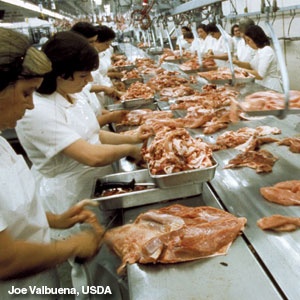175 birds a minute?

Without first studying the effects on assembly line workers, the U.S. Department of Agriculture has changed the rule on line speeds at poultry plants for the first time in more than a half-century, increasing the speed from 91 birds a minute to 175 birds a minute. An extended comment period on the new rule comes to a close at the end of this month.
The United Food and Commercial Workers, which represents poultry workers, has opposed the change, saying the USDA should first consider the effects on workers. An estimated 43 percent of poultry workers have shown indications of carpal tunnel syndrome and other musculoskeletal disorders, according to a 2007 Duke University study. Latino workers, a major portion of the poultry industry workforce today, are more than twice as likely to have such disorders as workers in other manual labor or low-skill jobs.
"Tens of thousands of poultry workers may soon find their already dangerous job becoming much more so, with almost no public debate," author Gabriel Thompson wrote in an article on the issue in The Nation's May 14 issue.
Using a strange logic, USDA claims the change actually will improve food safety by increasing pre-assembly line inspections and freeing staff to pay more attention to safety problems. It also will save taxpayers $90 million by reducing the overall number of online inspectors. Furthermore, Thompson writes, the rule will mean $257 million in annual savings to the industry.
As it made public its new rule, the USDA pledged to work with the National Institute for Occupational Safety and Health to determine how the rule change will affect workers.
That's exactly the reverse of what the process should be, the UFCW argues.
The USDA will accept comments on the rule through May 29 at 11:59 p.m. ET. To submit a comment, click here.
Tags
Joe Atkins
Joe Atkins is a professor of journalism at the University of Mississippi and author of "Covering for the Bosses: Labor and the Southern Press." A veteran journalist, Atkins previously worked as the congressional correspondent with Gannett New Service's Washington bureau and with newspapers in North Carolina and Mississippi.
